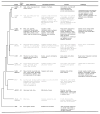Three Decades of Chloride Intracellular Channel Proteins: From Organelle to Organ Physiology
- PMID: 30040212
- PMCID: PMC6060641
- DOI: 10.1002/cpph.36
Three Decades of Chloride Intracellular Channel Proteins: From Organelle to Organ Physiology
Abstract
Intracellular organelles are membranous structures central for maintaining cellular physiology and the overall health of the cell. To maintain cellular function, intracellular organelles are required to tightly regulate their ionic homeostasis. Any imbalance in ionic concentrations can disrupt energy production (mitochondria), protein degradation (lysosomes), DNA replication (nucleus), or cellular signaling (endoplasmic reticulum). Ionic homeostasis is also important for volume regulation of intracellular organelles and is maintained by cation and anion channels as well as transporters. One of the major classes of ion channels predominantly localized to intracellular membranes is chloride intracellular channel proteins (CLICs). They are non-canonical ion channels with six homologs in mammals, existing as either soluble or integral membrane protein forms, with dual functions as enzymes and channels. Provided in this overview is a brief introduction to CLICs, and a summary of recent information on their localization, biophysical properties, and physiological roles. © 2018 by John Wiley & Sons, Inc.
Keywords: CLICs; chloride intracellular channels; intracellular organelles; ion channels; localization; mitochondria; physiology.
© 2018 John Wiley & Sons, Inc.
Figures


References
Publication types
MeSH terms
Substances
Grants and funding
LinkOut - more resources
Full Text Sources
Other Literature Sources

